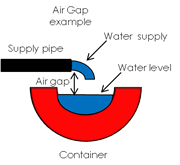
|
DISCLAIMER - IMPORTANT: PLEASE READ
This article is provided for information purposes only. You should only attempt any
procedures explained here if you are competent to perform the task and have the appropriate
tools and materials, including any relevant safety equipment.
Readers acting upon this article do so at their own risk and no responsibility is
accepted by the author or publisher for any loss or damage incurred by following the
article or failing to follow it.
If in doubt always consult a properly qualified tradesperson or other competent person.
|
|
WHAT IS AN AIR GAP?
An air gap is a device used to prevent water flowing backwards through
a supply pipe and possibly carrying contaminants with it back into the drinking water
supply.
Air gaps are typically used where the risk of contamination is greatest and other backflow prevention
devices such as check valves will not provide sufficient
protection.
HOW DOES AN AIR GAP WORK?
The air gap is literally just that - a gap between two water conductors.
Usually the air gap is formed by a water supply pipe terminating at a height over
a container.
The height of the air gap varies according to the risk of contamination.
As the contamination risk increases, or the nature of the contamination gets more
serious, so the air gap is increased.
|

AIR GAP
|
In the illustrated example, water falls from the end of the supply pipe into the container
and then continues its onward journey out of the container to the point of use.
The greater the height between the end of the pipe and the level of water in the container,
the greater the protection from backflow.
A common example of an air gap can be found in toilet cisterns. Water falls from the
inlet pipe into the cistern and the gap between the pipe and the water level provides
backflow protection. |
|
© 2012 Home
|